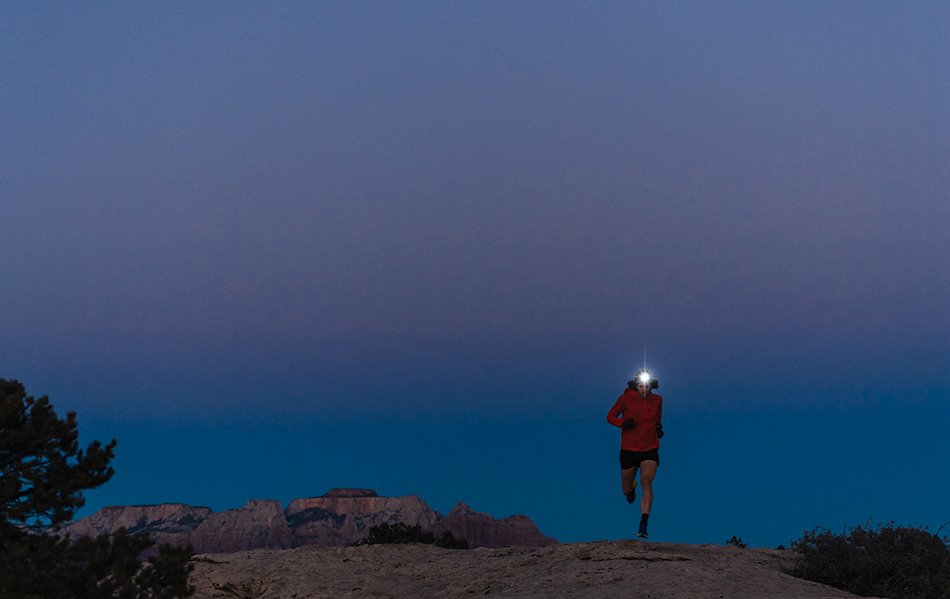Choosing the right headlamp can be daunting. From a wall full of lights that all look similar, covered in numbers that mean next to nothing, how do you pick the right one? To begin, understanding the lumen is the first step toward getting what you need. But, there’s more to know if you want to have the perfect headlamp for your next adventure.
So…what is it?
A lumen is the technical measurement of the amount of light emitted in all directions by a light source. More simply, a lumens rating indicates how bright a headlamp will shine with a fully charged battery. The more lumens a light has, the brighter it is.
Headlamps and other lights run the gamut of brightness. You’ll find anything from the 30-lumen, kid-friendly Black Diamond Wiz to the ultra-powerful, 750-lumen Petzl NAO+. The great thing about these headlamps is, they all have enough lumens for general use. Even those with the lowest lumen count provide enough illumination for an evening stroll around the campsite or a storm-bound day spent in the tent reading.

How many lumens do I need?
But, for other activities, you might need more lumens. So, how many should you get? The answer to that question is activity dependent. For movement-based activities, like night hiking or backpacking, a headlamp with a minimum of 150 to 200 lumens is best. There are exceptions, of course, like hiking the Presidential Range under a supermoon.
For faster-paced activities when you need to see farther ahead so you don’t trip (think nighttime trail-running), a light with more than 250 lumens is ideal. And, for activities like alpine climbing and mountaineering, when you might need a really bright light to briefly scope the next pitch or skirt some sketchy terrain, a lamp with a super-bright option (e.g., more than 350 lumens) will be really useful.
Most major manufacturers list a headlamp’s lumens on its package. It’s worth noting, however, that the majority will only be able to reach that number with fully charged batteries. More so, the higher power at which you operate your headlamp, the more battery power it consumes. Thus, it may make more sense to use a lower brightness to conserve battery life, rather than operate at the full 300 lumens.
Does the ability to adjust brightness interest you? To begin, make sure to check out the lights in Petzl’s Active series, like the Petzl Actik Core. A few Black Diamond models fall into this group, including the Icon and ReVolt.

So, lumen count is the only thing that matters. Right?
All that said, lumen count isn’t the be-all, end-all. It’s also important to consider how the headlamp directs the lumens. Generally referred to as the headlamp’s “beam,” the focusing of the lumens—from pinpoint to diffuse—greatly influences the activities for which the headlamp is ideal.
Types of Beams
A good example of a “general use” model is the 300-lumen Petzl Actik, which lets you toggle between wide and regular beams. Toggling makes the Actik ideal for use around the campsite, where the regular beam is perfect for precision tasks like cooking. The wide beam, meanwhile, is key for navigating around a site without blinding your fellow campers.
Alternately, a headlamp like the 300-lumen Black Diamond Spot has a more focused beam. Thus, it’s ideal for people doing precision work in the dark. Threading rappel anchors after being benighted, checking a climbing partner’s knot before an alpine start, and searching your pack for a midnight snack are all occasions where you benefit from a focused beam.
Some headlamps, such as the Black Diamond Sprinter—built for runners—are engineered to excel at one specific task. The Sprinter uses neither a wide, diffused light nor a concentrated proximity light. Rather, it produces a strong oval beam that is bright enough to illuminate potential hazards on the road or the trail, and shines far enough ahead so that you can anticipate upcoming terrain.
Reactive Lighting
A clear sign of just how far headlamps have advanced in recent years is Petzl’s reactive light technology. These advanced headlamps, like the Petzl Reactik, use a sensor to analyze the amount of ambient light in your environment, and adjust the brightness accordingly. This feature is particularly useful: It ensures you’re receiving just the right amount of light, it uses the headlamp’s battery as efficiently as possible, and it reduces any fiddling with buttons or dials. You can even control the Reactik’s settings via an app to prioritize everything from battery power to brightness.

Out Like a Light
The best thing about buying a headlamp at EMS is that there are no bad choices. Almost every model found on our shelves will provide enough lumens for whatever task you ask of it. And, for those looking for a headlamp to perform in a specific instance, manufacturers are rising to the occasion to fill those niches.
Tim Peck and Doug Martland
Tim and Doug met long ago at the Eastern Mountain Sports in Canton, Massachusetts. Bonding over a love of slick Quincy Quarry granite, White Mountain sufferfests, and scheming up adventures while folding tee-shirts, today Tim and Doug collaborate to write about their favorite outdoor activities and occasionally get nostalgic about tee-shirt tables.




